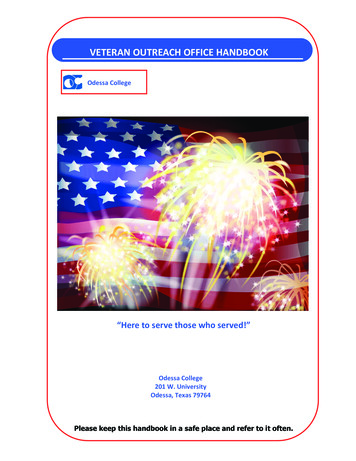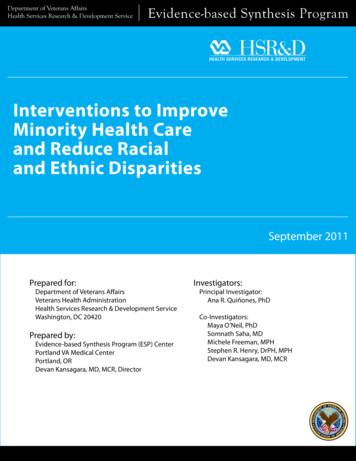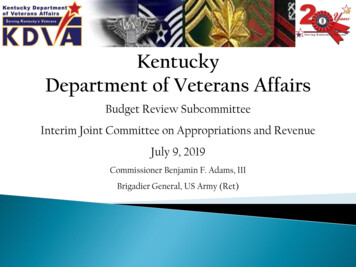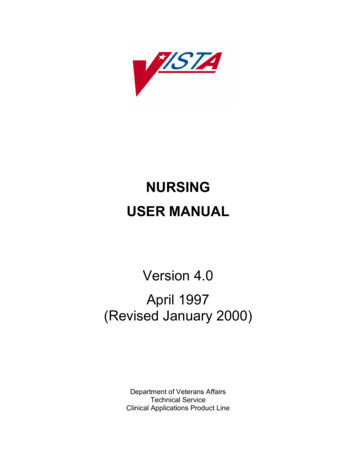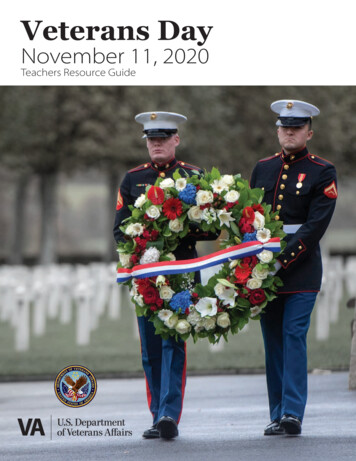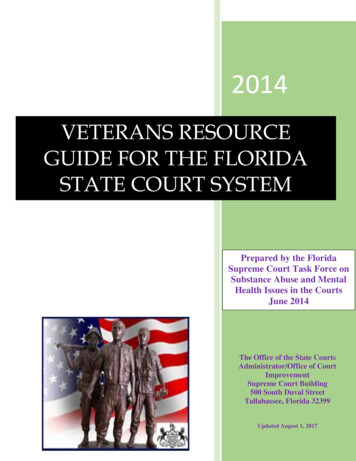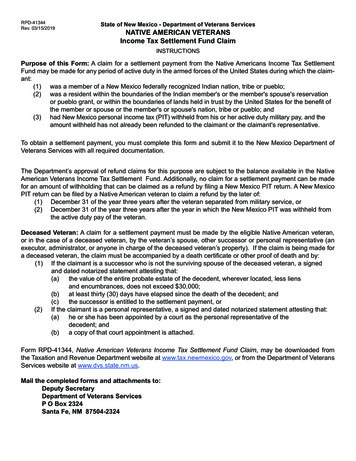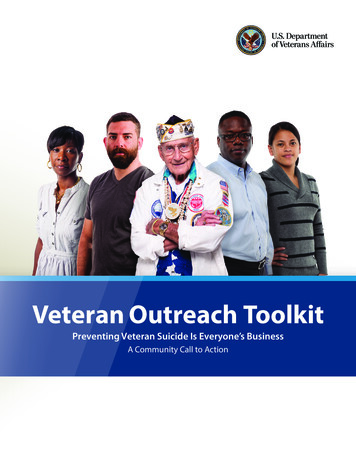
Transcription
Veteran Outreach ToolkitPreventing Veteran Suicide Is Everyone’s BusinessA Community Call to Action
ContentsCommunity Collaboration: Suicide Prevention Is Everyone’s Business 1Who Can Use the Community-Based Suicide Prevention Toolkit? 2Why Communities? 2How to Use the Community-Based Suicide Prevention Toolkit 3Community Tools 4Suicide Prevention Council 4Military Screening Questions 5Suicide Risk Assessment 6Suicide Prevention Safety Plan 7Myths and Realities About Suicide 8Communications Channels 9Public-Private Partnerships 910 Things You Can Do to Prevent Veteran Suicide 12#BeThere 16Publicly Available VA Resources 17iii
Community Collaboration: Suicide Prevention Is Everyone’s BusinessReaching all Veterans to prevent suicide will take the entire community.The U.S. Department of Veterans Affairs (VA) is on a mission to end suicide among Veterans incommunities across America. Approximately 14 of the 20 Veterans who die by suicide each day arenot receiving care from the Veterans Health Administration. We need your help to reach them. Weinvite you to share your insights, experiences, and resources to shape public health initiatives thatsupport Veterans at risk. One Veteran suicide is one too many. It’s time to act — Are you with us?VA works with hundreds of organizations and corporations at the national and local levels, includingVeterans Service Organizations, to raise awareness about its suicide prevention programs. Thesepartners have regular contact with Veterans as well as active duty Servicemembers, Reservists,National Guard members, and their families. By reaching out to help, communities can send themessage that they value these individuals and their service.Organized events are a great way for our partners to advance this critical national goal of endingVeteran suicide. By promoting Veteran-focused resources in your community at events such as jobfairs and wellness expos, you can help us reach all Veterans. Connecting with fellow Veterans tospread the word about valuable mental health and suicide prevention resources makes Veteranwellness a community priority.Veterans, family members, and care providers can initiate a free and confidential conversation with anexperienced and caring VA responder by calling the Veterans Crisis Line. If you are concerned aboutthe safety and well-being of a Veteran, call 1-800-273-8255 and Press 1. Chat online atVeteransCrisisLine.net/Chat to get support anonymously. A text message can also be sent to838255 to connect to a VA responder. These resources can be used even if a Veteran is not registeredwith VA or enrolled in VA health care.Veteran suicide is preventable, and suicide prevention is everyone’s business. Thank you for helpingto prevent and end Veteran suicide. Visit www.va.gov/nace/myVA/ for more information.1
Who Can Use the Community-Based Suicide Prevention Toolkit?Any community group can host events to raise awareness about mental wellness and suicideprevention programs or showcase best practices in health care and substance misuse treatment forVeterans. The following organizations are well-positioned to plan, promote, and participate in eventsthat support suicide prevention: Mental health and substance misuse treatment centers as well as primary care andwellness clinics Employers from both the public and private sectors who can provide job opportunities forVeterans transitioning from homelessness Organizations that can connect Veterans to one another through volunteer opportunities orpeer support programs Health clubs and gymsColleges and universitiesWhy Communities?VA leads the Nation’s largest and most integrated suicide prevention program and promotes continualprocess improvements across the entire health care system. To strengthen suicide preventionprograms and policies, VA conducted the most comprehensive analysis of Veteran suicide ratesin the U.S., examining more than 55 million Veteran records from 1979 to 2014. A key finding isthat 20 Veterans died by suicide in the U.S. each day, and 14 of those Veterans were not receivingcare from the Veterans Health Administration at the time of their death. VA released its report inAugust 2016 and is sharing this data with community-based health care providers and partnersto expand the network of support for Veterans before they are in crisis. To view the report, go rt.pdf.We need your help “finding the 14” who might be underserved by locating and connecting with theVeterans in your community! Your collaboration can magnify our suicide prevention efforts.2
How to Use the Community-Based Suicide Prevention ToolkitWhether you are hosting a career boot camp, exhibiting at a conference, planning a hiring event, orcoordinating a wellness expo in the community, this toolkit is for you! See the following suggestionsand tools needed to support Veterans in your community:1. Create or join a suicide prevention council.----Event ideas, timelines, and a planning checklistMessagingChallenges and action items2. Develop event promotion resources.-----Sample blogs and social media contentFlyer templateMedia advisory templateElectronic billboard messages to promote events within VA3. Share clinical tools for all providers.---Suicide Risk AssessmentSuicide Prevention Safety Plan Treatment Manual4. Promote safe storage of firearms, pills, and other means of self-harm.-----Suicide Risk AssessmentSuicide Prevention Safety Plan Quick GuidePosters and wallet cards for Make the Connection and the Veterans Crisis LineAdditional resources3
Community Tools1Suicide Prevention CouncilThe more we come together as a community to tackle this public health priority, the closer we canget to ending Veteran suicide.Every community has its unique assets, resources, stakeholders, and challenges. Consider workingwith others who have an interest in preventing suicide. Establish a coalition, council, or taskforce.Involve a diverse group representing different parts of the community: Health care providers (hospitals, clinics, family practitioners) Schools (public, private) Media representatives (radio, television, internet/podcast)Emergency services (ambulance companies, paramedics, firefighters)Law enforcement (police officers, sheriff departments, federal agencies such as the FederalBureau of Investigation, U.S. Postal Service, U.S. Homeland Security Department, VA)Local businesses (executives, managers, employees)Employee Assistance ProgramsChaplains and religious leadersVeteran-focused organizations (Veterans of Foreign War posts, American Legion, VeteransService Organizations, Team RWB)Funeral industry (medical examiners, coroners)VA Suicide Prevention CoordinatorsEach VA facility has Suicide Prevention Coordinators on-site to support Veterans and providers intimes of crisis. These case managers are vital parts of any community coalition to support Veterans.Use the VA resource locator to find your local VA Suicide Prevention Coordinator or call your localVA medical center to find out how the suicide prevention team can help.Community and Political LeadersWhether they’re members of your school board or neighborhood association, city leaders, or countyor state elected officials, political leaders can offer valuable support by using their unique networkingstrengths to promote suicide prevention as a public health priority.4
Law Enforcement and First RespondersAlthough first responders have valuable experience to share, they are often overlooked in publichealth initiatives, specifically suicide prevention. Police and sheriff departments, federal lawenforcement agencies, firefighters, ambulance teams, medical examiners, coroners, and emergencyroom staff all can provide firsthand information about needed resources and gaps that others in thecommunity may not be aware of. Many in these fields are military Veterans and committed to servingtheir communities.2Military Screening QuestionsAfter separating from the military, many Veterans continue to have a strong affiliation with theirservice. The military has a distinct culture, represented by the unique symbols, values, mottos, andtraditions of each branch: ArmyNavyAir ForceMarine CorpsCoast GuardReserve and National GuardDeployment and combat experiences are unique and can profoundly impact one’s life. (See the ActiveDuty vs. Reserve or National Guard handout in this toolkit.)Tips on Screening for Military Service You might want to post a simple sign in your office or in the lobby of your organization that letsVeterans and Servicemembers know that you would like to know if they have served. Respect a Veteran or Servicemember’s choice not to discuss their experiences. There are some questions that you may want to ask to clarify a client’s military background.Please review the Military Screening Questions handout included in this toolkit. It is important to ensure you have enough time available to allow the Veteran or Servicememberto expand on answers if desired.Convey a willingness to listen to their experiences if the Veteran or Servicemember wants todiscuss them in the future.For more information about screening for military service, go ary.asp.5
3Suicide Risk AssessmentWhat is a suicide risk assessment?A suicide risk assessment is a process in which a health care provider gathers clinical information todetermine a patient’s risk for suicide.When should I conduct a suicide risk assessment?Any person suspected to be at possible risk for suicide should be formally assessed.What tool can I use?Specific assessment and treatment protocols are in place across mental health services inevery VA facility. One of the tools in this kit is the VA Suicide Risk Assessment Guide, which canbe shared in the community. To view the guide online, go e.pdf.What are the key components of a suicide risk assessment?A suicide risk assessment should first evaluate warning signs in the three domains: suicidal thoughts,intent, and behavior. The assessment should then identify risk and protective factors that may increaseor decrease the client’s risk for suicide.What are warnings signs?Many suicidal individuals may reveal warning signs of their intention to engage in suicidal behavior.Learn to recognize these warning signs: hopelessness, feeling like there’s no way out, anxiety,agitation, sleeplessness or mood swings, feeling like there is no reason to live, rage or anger, engagingin risky activities, increasing alcohol or drug use, or withdrawing from family and friends. Veteran-specific risks. Frequent deployments; deployments to hostile environments; exposureto extreme stress; physical or sexual assault while in the service (not limited to women); lengthof deployments; or service-related injury Signs that require immediate attention. Thinking about hurting or killing themselves; lookingfor ways to die; talking about death, dying, or suicide; or self-destructive or risk-taking behavior,especially when it involves alcohol, drugs, or weapons At-risk communities. American Indian and Alaska Native (AI/AN) communities have troublingsuicide rates. Outreach events for AI/AN communities should be a community priority toincrease wellness, decrease stigma, and prevent suicide. Engaging leaders within the AI/ANcommunities, tribes, schools, and reservations is key to sharing resources. Building public healthcampaigns targeting AI/AN communities is a priority for organizations such as the Indian HealthService, National Action Alliance for Suicide Prevention, and Suicide Prevention Resource Center.6
4Suicide Prevention Safety PlanWhat is a safety plan?A safety plan is a list of prioritized coping strategies and resources that people at risk for suicide canuse during times of emotional distress or crisis. The plan is brief, easy to read, and written from aVeteran’s perspective.What resources can I use?Mental health assessment and treatment protocols at VA facilities can be shared in thecommunity. One of the tools is VA’s Safety Plan Quick Guide, which can be found online pdfHow do you develop a safety plan?Safety planning is a collaborative process between the Veteran at risk and a provider or friend. Theprovider and the client complete the safety plan together, and the client can use the plan to helpmanage a crisis.A safety plan should include six steps to assess the situation:1. Warning signs: “How will I know when the safety plan should be used?”2. Internal coping strategies: “What can I do to take my mind off my problems without contactinganother person?”3. People and social settings that provide distraction: “Are there people I can talk to or places I cango for a positive distraction from my suicidal thoughts?”4. People I can contact and ask for help: “Who can I call, text, or visit to get emotional support?”5. Professionals or agencies I can call during a crisis: “Do I have any health care providers,counselors, or other professionals I can call for help?”6. Making the environment safe: “What can I do to make my environment safer? Is thereanything I’ve thought of hurting myself with that should be removed or given to someone forsafekeeping?” (firearms, pills, rope)Fierce Loyalty: A Safety Plan VideoThis video shows health care providers the importance of encouraging Veteran patients and theirloved ones to create a safety plan they can implement if the Veteran is experiencing a crisis or may beat risk for suicide. The video includes testimonials from a VA Suicide Prevention Coordinator and a VAmedical center clinician explaining the significant impact a safety plan can have in helping a Veteranget the help he or she needs. To view and download, go to: VeteransCrisisLine.net/SpreadTheWord.7
Safety Plan Treatment ManualThe Safety Plan Treatment Manual, developed for use by VA clinicians and staff, describes a briefclinical intervention and safety planning for Veterans at risk for suicide. It can serve as a valuableadjunct to risk assessment and may be used for Veterans who have made a suicide attempt, haveconsidered suicide, have psychiatric disorders that increase suicide risk, or who are otherwisedetermined to be at high risk. It details how clinicians and clients can collaborate to develop and usesafety plans as intervention strategies to lower the risk of suicidal behavior. This approach is consistentwith the Recovery Model, which views Veterans as collaborators in their treatment and fostersempowerment, hope, and individual potential.5Myths and Realities About SuicideBelow are the top four myths about suicide that you can help dispel by taking action and sharing withyour community:1. MYTH: Asking about suicide may lead a Veteran to take his or her life.REALITY: Asking about suicide does not create suicidal thoughts. The act of asking the questionsimply gives the Veteran permission to talk about his or her thoughts or feelings.2. MYTH: There are talkers and there are doers.REALITY: Most people who die by suicide have communicated some intent. Someone whotalks about suicide provides others with an opportunity to intervene before suicidal behaviorsoccur. Almost everyone who dies by suicide or attempts suicide has given some clue or warning.Suicide threats should never be ignored. No matter how casually or jokingly said, statementslike, “You’ll be sorry when I’m dead,” or “I can’t see any way out” may indicate serious suicidalfeelings.3. MYTH: If somebody really wants to die by suicide, there is nothing you can do about it.REALITY: Most suicidal ideas are associated with treatable disorders. Helping someone connectwith treatment can save a life. The acute risk for suicide is often time-limited. If you can help theperson survive the immediate crisis and overcome the strong intent to die by suicide, you havegone a long way toward promoting a positive outcome.8
4. MYTH: He or she really wouldn’t die by suicide because he just made plans for a vacation, shehas young children at home, he made a verbal or written promise, she knows how dearly her familyloves her.REALITY: The intent to die can override any rational thinking. Someone experiencing suicidalthoughts or intent must be taken seriously and referred to a clinical provider who can furtherevaluate his or her condition and provide treatment as appropriate.6Communications ChannelsEnhancing connectedness is key to helping others feel cared about, and today there are multipleways to stay in touch with others and to show people that we care. Think of all the different formsof communication: face-to-face contact, sign language, talking on the phone or computer usingvideoconferencing tools such as FaceTime, text messaging and emails, online chatting, and writingletters. The internet has opened the doors to sharing useful information, including what yourcommunity is doing to bring Veterans and their families together. Consider setting up a website topromote community events and to promote substance misuse treatment options, wellness fairs, orother health services and activities unique to your area.One way to prevent suicide is to increase social connectedness. Many of the factors that putindividuals at a higher or lower risk for suicide are related to connectedness — the degree to whichan individual is close, interrelated, or shares mutual interests with another group. It can occur onmultiple levels, including among individuals, families, neighbors, schools, and cultural groups. TheCenters for Disease Control’s Strategic Direction for Suicide Prevention highlights research that linksconnectedness to suicide prevention. Using technology can enhance an individual’s social network,whether it’s starting a Facebook page to communicate with like-minded people or using Skype orFaceTime to talk with loved ones who live far away.7Public-Private PartnershipsThe VA Office for Suicide Prevention is working with public and private partners across the U.S. toensure that Veterans everywhere can access quality, timely mental health, and wellness resources. Thispublic health approach includes Veteran outreach, patient care, national crisis lines, and education andresearch to understand the risk and improve initiatives aimed at reducing suicide rates.The VA Office for Suicide Prevention is establishing a comprehensive and integrated network of publicprivate partnerships nationwide to address suicide prevention — including Veterans who are enrolledand those not enrolled with VA. Our goal is to reach Veterans and their families before a crisis starts. Wecan reach all Veterans by engaging employers and communities at large to provide resources abouthealth and wellness, mental health care, substance misuse treatment, and VA benefits.9
Use the following resources to learn more about wellness, employment, and treatment options to helpprevent and end Veteran suicide:Partnership Examples and Outreach ToolsSAMHSA Behavioral Health Provider Locator: www.findtreatment.samhsa.govPsychArmor Institute: www.psycharmor.org/military-cultureSuicide Prevention Resource Center: training.sprc.orgIndian Health Service Suicide Prevention and Care Program: www.ihs.gov/suicidepreventionGive an Hour: www.giveanhour.orgThe Campaign to Change Direction: www.changedirection.orgVA Mental Health programs: www.mentalhealth.va.govHomeless Veterans Community Employment Services: www.va.gov/homeless/hvces.aspVA Employment and Housing Toolkits: www.va.gov/homeless/get involved.aspVA Veterans Crisis Line Resource Locator: .aspxVA Community Provider Toolkit: s Crisis Line:Veterans, family members, and care providers can initiate a free and confidential conversation withan experienced and caring VA responder by calling the Veterans Crisis Line. If you are concernedabout the safety and well-being of a Veteran call 1-800-273-8255 and Press 1. Chat online atVeteransCrisisLine.net/Chat to get support anonymously. A text message can also be sent to838255 to connect to a VA responder. These resources can be used even if a Veteran is not registeredwith VA or enrolled in VA health care.Make the Connection:For Veterans who are not in immediate crisis, there are many treatment options andresources available. One universal resource is the Make the Connection website(www.MakeTheConnection.net), which provides a way for Veterans to privately exploremental health issues and difficult life experiences, and directs them to sources of support.Coaching Into Care:A free, confidential coaching service that helps families and friends discover constructive ways to talkwith Veterans about their concerns and treatment options. Visit www.mirecc.va.gov/coaching/ or call1-888-823-7458, from 8 a.m. to 8 p.m. Eastern Time.10
Additional References “Suicide Among Veterans and Other Americans 2001-2014,” released in August 2016 by VA’sOffice for Suicide Prevention: .pdf American Association of Suicidology: www.suicidology.orgHarvard T.H. Chan School of Public Health Means Matter: www.hsph.harvard.edu/means-matterCenters for Disease Control and Prevention: www.cdc.govNational Action Alliance for Suicide Prevention: www.actionallianceforsuicideprevention.orgMoving Forward: American Indian Alaska Native Suicide Prevention Resource Center: www.sprc.org/settings/aian11
10 Things You Can Do to Prevent Veteran Suicide1. Validate the Veteran’s experience: Show compassion. Crisis provides an opportunity to helppeople and give them hope. Suicide is preventable. Talk openly about suicide. Take deepbreaths yourself, and remember that we all have much in common with each other and thereare not always easy answers. Be willing to listen, and allow the Veteran to express his or herfeelings. Recognize that the situation is serious. Do not pass judgment. Reassure the Veteranthat help is available and offer hope. Listen more than you talk, and recognize that the Veteranwill feel that you care. Act with confidence and do not argue. Show compassion by looking atthe person talking or telling them that you care; compassion can be heard through your voiceand translates through your nonverbal communication.2. Recognize warning signs of suicidal thinking. Many Veterans may not show any signs ofintent to harm themselves before doing so, but some actions can be signs that they need help.Veterans who are considering suicide often show signs of depression, anxiety, low self-esteem,and/or hopelessness. These include: Appearing sad or depressed most of the timeHaving trouble sleeping and eating, orshowing loss of interest, which doesn’t goaway or continues to get worseFeeling anxious, agitated, or unable to sleepNeglecting personal welfareDeteriorating physical appearanceWithdrawing from friends, family, andsociety, or sleeping all the timeLosing interest in hobbies, work, school, orother things one used to care about Frequent and dramatic mood changesExpressing feelings of excessive guilt orshameFeelings of failure or decreasedperformanceFeeling that life is not worth living;having no sense of purpose in lifeTalking about feeling trapped, likethere is no way out of a situationFeelings of desperation, and saying thatthere’s no solution to their problemTheir actions may be dramatically different from their normal behavior, or they may appear tobe actively contemplating or preparing for a suicidal act. Unusual behaviors include: Performing poorly at work or schoolActing recklessly or engaging in riskyactivities — seemingly without thinkingShowing violent behavior, such as punchingholes in walls, getting into fights, orengaging in self-destructive violenceFeeling rage or uncontrolled anger orseeking revenge12 Looking as though one has a “death wish”Doing risky things, such as driving fastor running red lightsGiving away prized possessionsPutting affairs in order, tying up looseends, or making out a willSeeking access to firearms, pills, orother means of harming oneself
3. Ask the question: Are you having thoughts of suicide? Many people fear that asking aboutsuicide puts people more at risk. This is not true. By asking if someone is having thoughts ofsuicide or has hurt himself or herself, you are giving the person in need an opportunity to openup and share his or her feelings. This allows the Veteran to connect with you and allows you toinstill hope. DO ask the question, if you’ve identified warning signs or symptoms. DO ask thequestion in such a way that is natural and flows with the conversation. DON’T ask the questionas though you are looking for a “no” answer: “You aren’t thinking of killing yourself, are you?”DON’T wait to ask the question when he or she is halfway out the door.4. Means do matter: Know how to safely store firearms in your home. Most Veterans whodie by suicide use firearms. For someone in crisis, a locked firearm can mean the differencebetween a life saved and a tragic outcome. Though many Veterans are well-versed in gun safety,all Veterans and their families should understand how to properly handle and store firearms inthe home. There has been a rise in firearm suicides among female Veterans, in particular. Therisk of unintentional firearm deaths among youth drops by 80 percent when guns are storedseparately from ammunition in a lock box (Journal of the American Medical Association, 2005).VA Suicide Prevention Coordinators distribute free gun locks in their communities — talk topeople in your community and consider offering free gun locks from various agencies.Veterans also tend to inflict self-harm by overdosing on medication. Find out whether localhospitals and pharmacies provide free pill boxes to limit the amount of medication a Veteranhas access to during an emotional or difficult time. Encourage health care providers to limitthe amount of pills in any single prescription, especially if there is a significant risk of overdose.People who have recently been in an inpatient psychiatric unit or at an emergency room formental health or substance misuse are at increased risk for suicide for 90 days following theirdischarge. Consider working with pharmacists in your community to add a crisis line phonenumber to pill containers and prescription paperwork.5. Encourage treatment and expedite getting help. What should I do if I think someone issuicidal? Reassure the Veteran that help is available. Show compassion. Be honest; there are noquick answers. Treatment works. Sobriety is possible. Don’t keep the Veteran’s suicidal behaviora secret. Do not leave him or her alone. Take the Veteran to a local walk-in crisis center (checkwith your county) or call the county crisis line. Try to get the person to seek immediate helpfrom his or her doctor or the nearest hospital emergency room, or call 911. Once you havegotten the Veteran to seek help, reach out to them to show that you care. Emotional crisis canaffect us all; support goes a long way. Follow up with the person after the event; let him orher know that treatment works and that life can get better. Use the resource locator on theVeterans Crisis Line website: VeteransCrisisLine.net/ResourceLocator and use SAMHSA’s FindHelp and Treatment Locator: www.samhsa.gov/find-help.13
6. Promote Veteran employment: Help transition Servicemembers to civilian life.Transitioning back to civilian life when leaving the military can be incredibly challenging.Those recently transitioning out of the military have a higher risk for suicide. Findingemployment, understanding the opportunities available from vocational rehabilitationprograms, and financial stress can be overwhelming for anyone. Employers can work withVA community employment coordinators (CECs) — based at nearly every VA medical center— to share job openings and set up interviews with qualified Veterans. CECs prescreenVeterans who have a wide variety of skills and all levels of education to facilitate hiring andonboarding. Find the nearest CEC online at www.va.gov/homeless/cec-contacts.asp. HiringOur Heroes is a nationwide initiative to help Veterans, transitioning Servicemembers, andmilitary spouses find meaningful employment opportunities. For more information, .Collaborate with workforce investment boards, faith-based groups, homelessness services,housing organizations, VA medical centers, and employers to help Veterans develop resumes,polish interviewing skills, and access job opportunities. Recognize that Veterans have uniqueskills that translate well to the workforce, be it a specific trade or leadership experience. Promotedays of recognition at work, and offer additional resources about mental and physical wellnessand health care options, employee assistance programs, gym memberships, and other benefitsto your Veteran employees.7. She also served: Recognizing and connecting with women Veterans. Women Veteransmake up a growing segment of our community. Women Veterans have a significantly highersuicide risk than their non-Veteran civilian counterparts: Adjusting for differences in age,risk for suicide is 2.4 times higher among female Veterans when compared with U.S. civilianadult females (Suicide Among Veterans and Other Americans 2001-2014, VA Office for SuicidePrevention, Aug. 3, 2016).Communities often fail to recognize women as Veterans. Consider reaching out to partners toensure that any messaging for Veterans considers women and men. Host an event for womenVeterans, and consider reaching out to key leaders in the community who can help connectthem to one another. Women Veterans face many unique challenges, such as caregivingresponsibilities and asking for help when in need. Health care providers should take care toassess all women in crisis against the sa
prevention programs or showcase best practices in health care and substance misuse treatment for Veterans. The following organizations are well-positioned to plan, promote, and participate in events that support suicide prevention: Mental health and substance misuse treatment centers as well as primary care and wellness clinics
